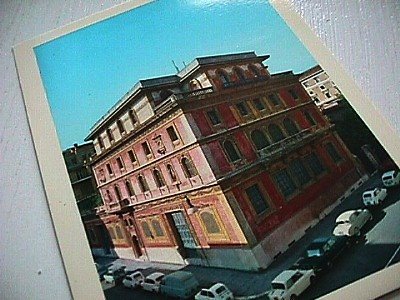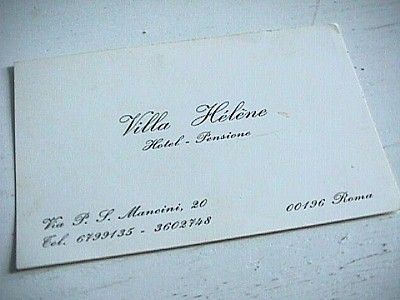2006.03.06 14:30
God's will as urban planning?
Just thought it worth mentioning that the full title of St. Augustine's The City of God is The City of God Against the Pagans.
2006.04.04 12:11
Re: Constantine and Christians
...read the passages within Eusebius' Life of Constantine, Book III, Chapters 54-58, demolition of the shrine at Aphaca in particular. These demolitions of pagan temples are recorded immediately following the chapters about the Christian church building projects in the Holy Land and other locations in the East. I find the (historical) juxtaposition of Constantine's creative and destructive religious activities interesting--while Christianity was beginning to be 'built', paganism was starting to be 'demolished', and seemingly starting with the more homosexually oriented cults.
2006.04.04 12:51
Re: Constantine and Christians
It is perhaps wrong to say that Constantine was influenced by Helena and Eutropia when it came to Christianity, but there is no question that Constantine acted in tandem with Helena and Eutropia when it came to manifesting Christian churches. Helena's work is relatively well know here, but Eutropia's work is often ignored. Here is a letter from Constantine to Eusebius (as a bishop in Palestine), which Eusebius includes within the Life of Constantine after recording the death of Helena:
"VICTOR CONSTANTINUS, MAXIMUS AUGUSTUS, to Macarius, and the rest of the bishops in Palestine.
"One benefit, and that of no ordinary importance, has been conferred on us by my truly pious mother-in-law, in that she has made known to us by letter that abandoned folly of impious men which has hitherto escaped detection by you: so that the criminal conduct thus overlooked may now through our means obtain fitting correction and remedy, necessary though tardy. For surely it is a grave impiety indeed, that holy places should be defiled by the stain of unhallowed impurities. What then is this, dearest brethren, which, though it has eluded your sagacity, she of whom I speak was impelled by a pious sense of duty to disclose?
That the Saviour appeared in this Place to Abraham. She assures me, then, that the place which takes its name from the oak of Mambre, where we find that Abraham dwelt, is defiled by certain of the slaves of superstition in every possible way. She declares that idols which should be utterly destroyed have been erected on the site of that tree; that an altar is near the spot; and that impure sacrifices are continually performed. Now since it is evident that these practices are equally inconsistent with the character of our times, and unworthy the sanctity of the place itself, I wish your Gravities to be informed that the illustrious Count Acacius, our friend, has received instructions by letter from me, to the effect that every idol which shall be found in the place above-mentioned shall immediately be consigned to the flames; that the altar be utterly demolished; and that if any one, after this our mandate, shall be guilty of impiety of any kind in this place, he shall be visited with condign punishment. The place itself we have directed to be adorned with an unpolluted structure, I mean a church; in order that it may become a fitting place of assembly for holy men. Meantime, should any breach of these our commands occur, it should be made known to our clemency without the least delay by letters from you, that we may direct the person detected to be dealt with, as a transgressor of the law, in the severest manner.
For you are not ignorant that the Supreme God first appeared to Abraham, and conversed with him, in that place. There it was that the observance of the Divine law first began; there first the Saviour himself, with the two angels, vouchsafed to Abraham a manifestation of his presence; there God first appeared to men; there he gave promise to Abraham concerning his future seed, and straightway fulfilled that promise; there he foretold that he should be the father of a multitude of nations.
For these reasons, it seems to me right that this place should not only be kept pure through your diligence from all defilement, but restored also to its pristine sanctity; that nothing hereafter may be done there except the performance of fitting service to him who is the Almighty God, and our Saviour, and Lord of all. And this service it is incumbent on you to care for with due attention, if your Gravities be willing (and of this I feel confident) to gratify my wishes, which are especially interested in the worship of God. May he preserve you, beloved brethren!"
I think it is clearly implied that Constantine sooner trusts Eutropia than the Christian bishops, and, moreover, Eutropia provided Constantine with a further occasion to demonstrate his superiority over the bishops. What is unfortunate is that modern scholars cannot accept that Eutropia was still alive and still on good terms with Constantine after the deaths of Helena and (of course) Fausta.
I've said it here before, and I'll say it again: a lot of the conundrums of Helena cleared up once I stopped ignoring Eutropia.
To me, Constantine was a soldier first, a politician second and a Christian third. Helena, I see, as a great historical player, a great survivor and a great doer. And, I see Eutropia, because of her long Imperial life and vast experiences, as the person closest to Constantine who knew 'everything'--she knew the Empire and its many places and how it all worked (literally and symbolically), and she probably knew who owned what.
| |
2006.06.01
Villa Hélène
The last time I was in Rome I was staying at the Villa Hélène, Via P. Stanislao Mancini, 20, near the Tiber just a few blocks outside the Popolo Gate.


AP wrote:
"all the obvious stuff...also, be sure not to miss St. John Lateran, if you're into the whole church thing...beautiful church, across the street are the Scala Santa - steps that once lead to Pontius Pilate's home in Jerusalem. History suggests that Jesus scaled these steps just before his judgement. St. Helena brought 'em back to Rome, along with other relics...you can only scale the steps on your knees, typically stopping at each for prayer..."
According to Hans A. Pohlsander, Helena: Empress and Saint (1995), p. 81:
"A short distance from the Basilica of St. John Lateran, in the Piazza San Giovanni, we find the Scala Santa, a building erected by Domenico Fontana under Pope Sixtus V (1585-1590). It is a place of pilgrimage, where the faithful ascend the central stairs of the building only on her knees. The 28 marble steps of these stairs were salvaged from the original Lateran Palace. According to tradition they were brought by Helena from the palace of Pontius Pilate in Jerusalem. This tradition can be traced back no further than the 13th century."
You know, it really wasn't St. Helena that brought the steps to Rome because it was really Helena's granddaughter Helena, the youngest of Constantine and Fausta's children and the wife of (first cousin) Julian the Apostate. While Julian was busy rebuilding the Jewish Temple of Jerusalem, Helena had the Pontius Pilate palace steps shipped to Rome for safekeeping at the Domus Fausta, her mother's quondam palace at the Lateran.
| |
2006.06.15 13:32
UPenn M.Arch Summer Reading List
Question at job interview:
"So, which reading list do you reenact?"
2007.02.07
fuzzy vs. fussy
Is there an architecture of fuzzy logic? And is there an architecture of fussy logic? Is there something fuzzy about what Robertson said and is there something fussy about what Sink said? Could I make an argument as to the distinction in just the books I've been reading lately?
John James Audubon
Architecture in Words: theater, language and the sensuous space of architecture
Archeticture: ecstasies of space, time and the human body
Leon Battista Alberti's Hypnerotomachia Poliphili.
2007.06.01 18:24
Archinect Book Club?
Why not pick one of the free online books from 010 Publishers?
Actually, I'm more interested in finding out how global this free offer via google/books really is. Is this available to European web users? South American web users? Asian web users?
Now I really don't regret selling my copy of Metacity/Datatown on eBay. I love using the screen save command.
2007.07.31 17:55
Necessary architecture books
Not just reading other things, how about writing other things too? Architectural literature could be so much more creative.
2007.07.31 20:28
Necessary architecture books
Reading and writing go hand in hand, and that's what's very creative about writing within cyberspace, the integralness of reading and writing.
There's so much to read now and there are so many ways to write/publish now, and I've become very fond of the places where you can actually do both.
As to books, I had and still have many, and at this point I'm seriously thinking of taking a lot of them apart and then mixing and rearranging all the various pages into a series of new books. Maybe I'm foolish, but I anyhow imagine there's a great untapped realm beyond the status quo.
2008.04.04 12:36
READING LIST
Currently reading Privacy and Publicity: Modern Architecture as Mass Media, and got up to p. 84 yesterday morning while waiting for the repair of an automatic car window. There is an unfortunate manuscript error on page 68:
lines 1-4
Benjamin cites a sentence of Theodor Reik... Remembrance is essentially conservative; memory is destructive."
lines 14-15
In these terms, Reik's distinction between conservative memory and destructive remembrance...
As they stand (at least in the 1994 hardback edition), these lines contradict each other, and thus completely confuse the issue. Now checking the source, lines 1-4 correctly recall Reik's distinction.
Staying on page 68, I (personally) use/translate Erfahrung as 'a knowledge of', and Erlebnis as 'an actual experience of', in the sense that Erfahrung is more or less a reenactment of Erlebnis.
| |
2008.04.04 13:56
READING LIST
I can't answer for others, but lately my architectural theories involve a conjunction of Erlebnis und Erfahrung.
2008.04.05 10:32
READING LIST
Page 68 of Privacy and Publicity: Modern Architecture as Mass Media is loaded, and the dyslexical error therein provides a spark capable of igniting an explosion. More truth may in fact lie with the notion that the attributes of memory and remembrance are indeed interchangably fluid rather than strictly opposed. Le Corbusier's 'doctoring' of photography (as discussed in the chapter after page 68) even seems to be a perfect example of the interchangable fluidity of memory and remembrance.
--Balloon and Prick: Modern Reading as Virtual Architecture, (forthcoming).
currently on my 'book table':
Privacy and Publicity: Modern Architecture as Mass Media
The Limits of Interpretation
The Changing Light at Sandover
Labyrinths
The Architecture of Humanism: A Study in the History of Taste
The Fifties
The Rise of Scientific Philosophy
Promises, Promises: Essays on Psychoanalysis and Literature
Difference & Repetition
Man and Time
The Anaesthetics of Architecture
The Diaries of Paul Klee
Illuminations
Reflections
Edmund Husserl's Origin of Geometry: An Introduction
"The Boudoir in The Expanded Field"
The Production of Space
Art in America, April 2008
Artforum, April 2008
51N4E space producers
Shrinking Cities
Festival Architecture
Future City: Experiment and Utopia in Architecture
Yves Brunier, Landscape Architect
...perhaps a sign of being neither student nor architect; sondern etwas anderes.
2008.04.05 14:05
READING LIST
It may be well worth noting that the publication of S,M,L,XL closely coincides with the dawn of the easily-browsable/easily-publishable hypersized internet. Ends and beginnings are both extreme situations.
2008.04.05 16:49
READING LIST
S,M,L,XL is indeed a kind of "browsable" book that predates the internet in its breadth, and, for me at least, has stimulated publishing via the internet.
As far as I'm concerned, the internet makes "creating a fixed/fluid, massive, all-encapsulating text" even more possible.
|